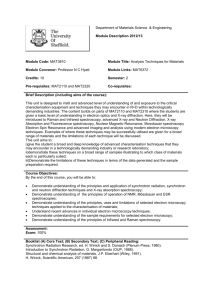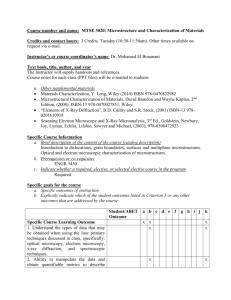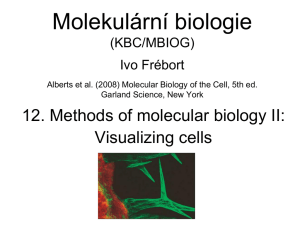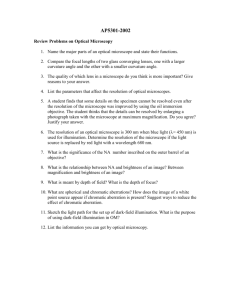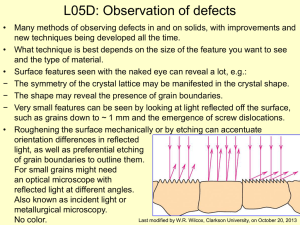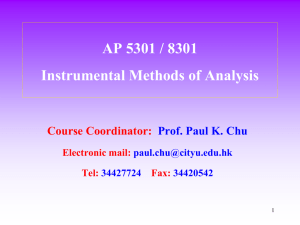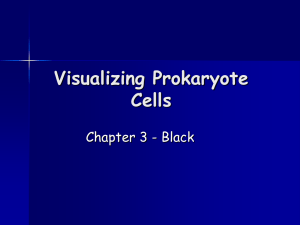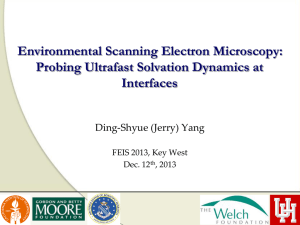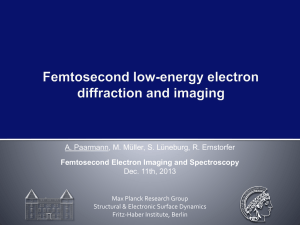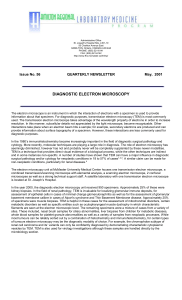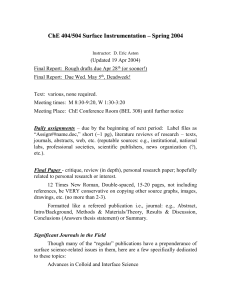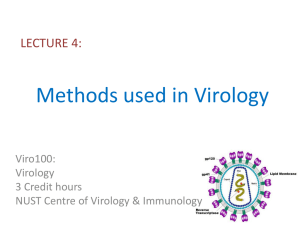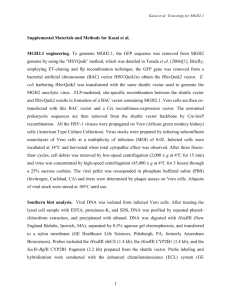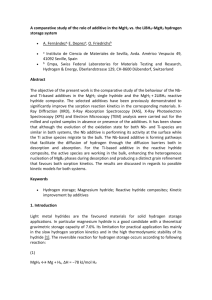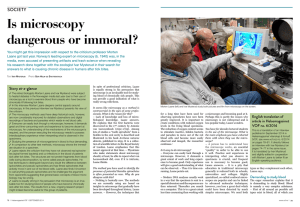Some examples
advertisement
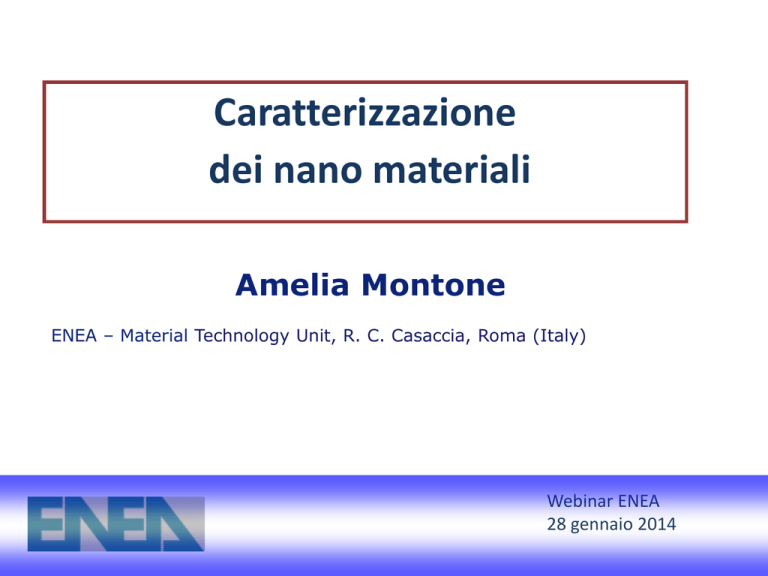
Caratterizzazione dei nano materiali Amelia Montone ENEA – Material Technology Unit, R. C. Casaccia, Roma (Italy) Webinar ENEA 28 gennaio 2014 Classification of nanomaterials 3 dimensions at nanoscale 1 dimensions outside the nanoscale ad so on… nanomaterials can be… • amorphous or crystalline •single crystalline or polycrystalline •composed by single or multichemical elements •Exhibit various shapes and forms •Exist individually or incorporated in a matrix •metallic, ceramic, or polymeric The role of the characterization structure nanomaterial properties chemical composition characterization methods shape imaging techniques some kind of microscopy analytical techniques some type of spectroscopy Types of characterization techniques Types of characterization techniques Optical /Confocal Microscopy Diffraction limit defines spatial resolution, fraction of mm range First place you want to ‘look’ “Non Conventional” Optical /Confocal microscopy Near-Field Scanning Optical Microscope (NSOM) resolution 50 nm Confocal Scanning Light Microscope lateral resolution 100− 200 nm, vertical resolution 400− 500 nm. 3-D image of the specimen Electron Microscopy Diffraction limit defines spatial resolution, fraction of nm range Why electrons? Spatial resolution of wichever instrument using lenses for obtaining a magnified image of an object Electron wavelength depends on the kinetic energy according to the De Broglie equation. is limited by diffraction effects to a minimum value essentially determined by the wavelength. R=0,61/n sina (E.Abbe 1873) Visible light has wavelength in the fraction of mm range, while interatomic distances are about three order of magnitude smaller. =1.22/E1/2 (De Broglie 1926) Electron Microscopy Scanning Electron Microscopy (SEM), Transmission Electron Microscopy (TEM), Scanning Transmission Electron Microscopy (STEM). every signal gives a different kind of information SE Some examples (SEM) Optical Microscope Mg° (metallic) Phase A Mg° (metallic) BSE Phase B Mg/MgH2 10h milled conductive matrix (aluminium) Some examples (SEM) SEM: powder of the pellet MgH2+10Nb2O5+5ENG – after cycling Hollow and catalyst depleted particles Catalyst depleted particles Hollow particles D. Mirabile Gattia, A. Montone, L. Pasquini, Int. J. Hydrogen Energy 38 (2013) 1918 Some examples (SEM) MgH2 + 5wt% ENG EDS map ~600MPa – Nb2O5 Some examples (SEM) Pt deposited by PVD By using carbon nanostructures as high specific surface support for the catalyst, a better dispersion of the nanoparticles is obtained compared to traditional support (Vulcan CX-72R) Pt deposited by electrodeposition L.Giorgi et al. Sensors and Actuators B 126 (2007) 144–152 Some examples (TEM) arc discharge in gaseous environments for synthesis of nano C structures MWNT SWNT • D. Mirabile Gattia, M. Vittori Antisari, R. Marazzi, Nanotechnology 18 (2007) 255604 • M. Vittori Antisari, D. Mirabile Gattia, R. Marazzi, E. Piscopiello, A. Montone, Mater. Res. Soc. Symp. Proc. 1142 (2009) JJ05-16 Scanning Probe Microscopy Scanning Tunneling Microscope (STM) Atomic Force Microscope (AFM) Scanning Probe Microscopy the ability to monitor very small variations in topography. Scanning Tunneling Microscope (STM) sub-angstrom vertical resolution atomic lateral resolution STM image of silicon (111) 7x7 surface reconstruction Atomic Force Microscope (AFM) atomic scale resolution AFM image of carbon nanotubes Analytical Techniques electron kind of information Chemical Composition Chemical Bonding X-Ray Microanalysis Electron Energy Loss Spectroscopy (EELS) Infrared (IR) Spectroscopy Raman Spectroscopy vibrational spectroscopy light X-Ray Diffraction Analytical Techniques X-Ray Microanalysis 1. 2. 3. Ionization of electrons belonging to inner shells of atoms electrons decay to their relaxed states X-rays are emitted with energies unique to the ionized atom. minimum detectability 0.1 at% E1 E2 E3 Some examples Some examples Apollo di Veio Some examples Mongolfiera Garnerin (anno 1804) Analisi chimica zona grigia Analisi chimica zona bianca Analytical Techniques Electron Energy Loss Spectroscopy (EELS) measure the energy loss of inelastic scattered electrons atomic resolution chemical analysis chemical bonding information Width of zero-loss peak, typically 0.2–2 eV, reflects mainly the energy distribution of the electron source Edges suitable for EELS microanalysis for the energy range ( 0-3 keV) Some examples Elemental mapping Titanium Neodymium 3 images/element using: Nd M45 edge: Ti L23 edge: Ba M45 edge: @ 978 eV @ 455 eV @ 781 eV Color overlays, RGB images: RGB image Barium Ti 200nm Nd Ba • assign a color to each elemental map: Ti green, Nd blue and Ba red • Superimpose three color layers to form RGB composite • shows chemical phase distribution qualitatively only Analytical Techniques infrared (IR) Spectroscopy differences in the chemical and atomic structure of materials give rise to specific vibrational characteristics and yield unique IR spectra for each material. In the case of nanomaterials is used to determine the extent of absorption of foreign species in nanoparticles of different sizes as well as the structure of nanorods, nanowires, and carbon nanotubes Infrared spectrum of carbon nanotubes synthesized by chemical vapor deposition Analytical Techniques Raman spectroscopy Complementary to IR spectroscopy: some vibrational modes IR-active, others Raman-active extensively used for CN: their mode frequencies are a function of size and chirality changes in nanoparticle size: Raman spectrum tends to broaden and shift to lower frequencies as the particle size decreases Size-dependent properties of CeO2-y nanoparticles by Raman scattering Analytical Techniques X-ray Diffraction peak intensity depends on - structure factor, which is related to the position of atoms within the unit cell - shape factor , and it is related to the size of the crystal Bragg’ s law of diffraction. 2d sina = n schematic X-ray diffrattometer Some examples Sample: MgH2 + 5wt%TiO2 + 5wt% ENG Cycling Parameters: 340°C – 1.2bar/8bar Rietveld analysis As milled Cell parameters (nm) TiO2 anatase -MgH2 -MgH2 MgO a 0,37965 0,45279 0,45386 0,42325 b - - 0,54326 - c 0,95381 0,30292 0,49705 - 181 10 8 11 TiO2 anatase -MgH2 -MgH2 MgO a - 0,45085 - 0,42286 b - - - - c - 0,30239 - - - 157 - 10 Crystallite size (nm) Cycled Cell parameters (nm) Crystallite size (nm) Some examples Sample: MgH2 + 10wt%Nb2O5 + 5wt% ENG Experimental conditions Desorption: 1.2 bar – 310 °C Adsorption: 4 bar – 310 °C After 2h air exposure 100 cycles a) as milled MgH2 with Nb2O5 and ENG b) pellet exposed to air after cycling, after complete absorption run c) MgH2 as purchased Cycled sample: • Mg-Nb-O ternary oxide is formed • Nb2O5 crystalline phase is not present • Mg(OH)2 crystalline phase is absent Thank for your attention! amelia.montone@enea.it

